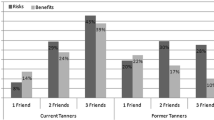Abstract
Adolescent and young adult men are a potentially overlooked population with respect to risky tanning behaviors. This study sought to determine the prevalence of various modes of tanning and associated variables among young men in a university setting in the southeastern United States. Undergraduate students at a public institution in Mobile, Alabama were surveyed electronically in March 2016. Of the 818 undergraduate men surveyed, over 90% reported tanning behaviors, with 37% reporting engaging in indoor tanning. Additionally, over 25% reported engaging in two or more types of tanning concurrently. These findings indicate that early intervention efforts targeting young men are needed to reduce risky tanning behaviors and associated negative health outcomes.
Similar content being viewed by others
References
ACS. (2016). Basal and squamous cell skin cancer risk factors. Retrieved from https://www.cancer.org/cancer/basal-and-squamous-cell-skin-cancer/causes-risks-prevention/risk-factors.html.
ACS. (2017). Cancer facts and figures 2017. American Cancer Society.
Ashrafioun, L., & Bonar, E. E. (2014). Tanning addiction and psychopathology: Further evaluation of anxiety disorders and substance abuse. Journal of the American Academy of Dermatology, 70(3), 473–480. https://doi.org/10.1016/j.jaad.2013.10.057.
Blashill, A. J. (2013). Psychosocial correlates of frequent indoor tanning among adolescent boys. Body Image, 10(2), 259–262. https://doi.org/10.1016/j.bodyim.2012.11.005.
Blashill, A. J., & Pagoto, S. (2017). Effect of legislation on indoor tanning prevalence in Alabama. American Journal of Public Health, 107(6), 966–968. https://doi.org/10.2105/ajph.2017.303716.
Chait, S. R., Thompson, J. K., & Jacobsen, P. B. (2015). Preliminary development and evaluation of an appearance-based dissonance induction intervention for reducing UV exposure. Body Image, 12, 68–72. https://doi.org/10.1016/j.bodyim.2014.09.004.
Colantonio, S., Bracken, M. B., & Beecker, J. (2014). The association of indoor tanning and melanoma in adults: Systematic review and meta-analysis. Journal of the American Academy of Dermatology, 70(5), 847–857.e841-818. https://doi.org/10.1016/j.jaad.2013.11.050.
Hillhouse, J., Turrisi, R., Scaglione, N. M., Cleveland, M. J., Baker, K., & Florence, L. C. (2017). A web-based intervention to reduce indoor tanning motivations in adolescents: A randomized controlled trial. Prevention Science, 18(2), 131–140. https://doi.org/10.1007/s11121-016-0698-4.
Holman, D. M., Berkowitz, Z., & Guy, G. P., et al. (2015). Patterns of sunscreen use on the face and other exposed skin among US adults. Journal of the American Academy of Dermatology, 73(1), 83.e81–92.e81. https://doi.org/10.1016/j.jaad.2015.02.1112.
Holman, D. M., Fox, K. A., Glenn, J. D., & Guy, G. P., et al. (2013). Strategies to reduce indoor tanning: Current research gaps and future opportunities for prevention. American Journal of Preventive Medicine, 44(6), 672–681. https://doi.org/10.1016/j.amepre.2013.02.014.
Holman, D. M., & Watson, M. (2013). Correlates of intentional tanning among adolescents in the United States: A systematic review of the literature. Journal of Adolescent Health, 52(5), S52–S59. https://doi.org/10.1016/j.jadohealth.2012.09.021.
Julian, A. K., Bethel J. W., & Odden, M. C., et al. (2016). Sex differences and risk behaviors among indoor tanners. Preventive Medicine Reports, 3, 283–287. https://doi.org/10.1016/j.pmedr.2016.03.011.
Lazovich, D., Vogel, R. I., Weinstock, M. A., Nelson, H. H., Ahmed, R. L., & Berwick, M. (2016). Association between indoor tanning and melanoma in younger men and women. JAMA Dermatology, 152(3), 268–275. https://doi.org/10.1001/jamadermatol.2015.2938.
Lazovich, D, Vogel, R. I., & Weinstock, M. A., et al. (2016). Association between indoor tanning and melanoma in younger men and women. JAMA Dermatology, 152(3), 268–275. https://doi.org/10.1001/jamadermatol.2015.2938.
Lostritto, K., Ferrucci L. M., Cartmel, B., Leffell, D. J., et al. (2012). Lifetime history of indoor tanning in young people: A retrospective assessment of initiation, persistence, and correlates. BMC Public Health, 12(118), 1–9.
Mitsis, D. K. L., Groman, A., & Beaupin, L. M., et al. (2015). Trends in demographics, incidence, and survival in children, asolescents, and young adults (AYA) with melanoma: A Surveillance, Epidemiology, and End Results (SEER) population-based analysis. Journal of Clinical Epidemiology: Official Journal of the American Society of Clinical Oncology, 152(3), 268–275.
Miyamoto, J., Berkowitz, Z., & Jones, S. E., et al. (2012). Indoor tanning device use among male high school students in the united states. Journal of Adolescent Health, 50(3), 308–310. https://doi.org/10.1016/j.jadohealth.2011.08.007.
Pagoto, S. L., Schneider, K. L., Oleski, J., Bodenlos, J. S., & Ma, Y. (2010). The sunless study: A beach randomized trial of a skin cancer prevention intervention promoting sunless tanning. Archives of Dermatology, 146(9), 979–984. https://doi.org/10.1001/archdermatol.2010.203.
Siegel, R. L., Miller, K. D., & Jemal, A. (2017). Cancer statistics, 2017. CA: A Cancer Journal for Clinicians, 67(1), 7–30. https://doi.org/10.3322/caac.21387.
Wehner, M. R., Chren M. M., & Nameth, D., et al. (2014). Early-only basal call carcinoma and indoor tanning: A population-based study. JAMA Dermatology, 150(4), 390–400.
Yoo, J. J. (2009). Peer influence on adolescent boys’ appearance management behaviors. Adolescence, 44(176), 1017–1031.
Funding
The authors received no financial support for the research, authorship, and/or publication of this article.
Author information
Authors and Affiliations
Corresponding author
Ethics declarations
Conflict of interest
Dr. Daniel, Ms. Fernandez, Dr. Gassman, Dr. Bae, Dr. Blashill and Dr. Tan declares that they have no conflicts of interest.
Rights and permissions
About this article
Cite this article
Daniel, C.L., Fernandez, A.M., Gassman, N.R. et al. Significant Engagement in Tanning Behaviors by Men at a U.S. University. J Community Health 43, 656–659 (2018). https://doi.org/10.1007/s10900-017-0464-y
Published:
Issue Date:
DOI: https://doi.org/10.1007/s10900-017-0464-y



